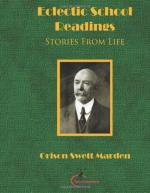And then a mighty thought flashed across the brain of the poor, humble, unknown churchwarden, a thought the realization of which was destined not only to make him famous for all time, but to revolutionize the whole world. The first dim suggestion came to him in this form, “By having a series of letters and impressing them over and over again on parchment, cannot books be printed instead of written, and so multiplied and cheapened as to be brought within the reach of all?”
The remainder of his life was given up to developing this great idea. He cut more letters from bark, and, covering the smooth surface with ink, pressed them upon parchment, thus getting a better impression, though still blurred and imperfect. He then cut letters from wood instead of bark, and managed to invent himself a better and thicker ink, which did not blur the page. Next, he cut letters from lead, and then from pewter. Every hour was absorbed in the work of making possible the art of printing. His simple-minded neighbors thought he had lost his mind, and some of the more superstitious spread the report that he was a sorcerer. But, like all other great discoverers, he heeded not annoyances or discouragements. Shutting himself away from the prying curiosity of the ignorant and superstitious, he plodded on, making steady, if slow, advance toward the realization of his dream.
“One day, while old Coster was thus busily at work,” says George Makepeace Towle, “a sturdy German youth, with a knapsack slung across his back, trudged into Haarlem. By some chance this youth happened to hear how the churchwarden was at work upon a wild scheme to print books instead of writing them. With beating heart, the young man repaired to Coster’s house and made all haste to knock at the churchwarden’s humble door.”
The “sturdy German youth” who knocked at Laurence Coster’s door was Johann Gutenberg, the inventor of modern printing. Coster invited him to enter. Gutenberg accepted the invitation, and then stated the object of his visit. He desired to learn more about the work on which Coster was engaged. Delighted to have a visitor who was honestly interested in his work, the old man eagerly explained its details to the youth, and showed him some examples of his printing.
Gutenberg was much impressed by what he saw, but still more by the possibilities which he dimly foresaw in Coster’s discovery. “But we can do much better than this,” he said with the enthusiasm of youth. “Your printing is even slower than the writing of the monks. From this day forth I will work upon this problem, and not rest till I have solved it.”
Johann Gutenberg kept his word. He never rested until he had given the art of printing to the world. But to Laurence Coster, in the first place, if legend speaks truth, we owe one of the greatest inventions that has ever blessed mankind.




